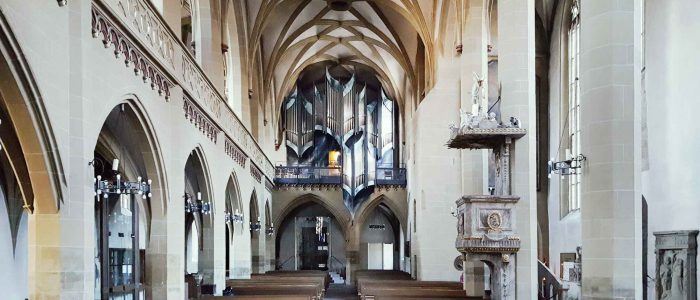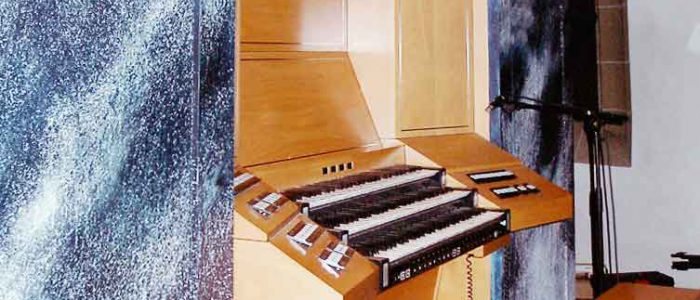Kitzingen, St. Johannes d. T. , III/54 – Opus 303

Als die Orgel und das Gemälde eins wurden...
Kitzingen Stadtpfarrkirche St. Johannes, Orgelneubau 1996 / 2007
Das sehr aufwendige und herstellungstechnisch besonders anspruchsvolle Orgelgehäuse nimmt den Gedanken der Asymmetrie des Kirchenraumes auf. Das Rückpositiv ist von der Kirchenachse 2/3 nach rechts verschoben, die dahinter tiefen- und höhengestaffelten Werke führen das Instrument wieder zur Symmetrie. Die Orgel verbindet und kontrastiert den bogenförmigen Unterbau der Empore mit den Elementen des gotischen Deckengewölbes, das mit dem Obergehäuse eine fließende Verbindung eingeht. Spannungssteigernd wirken die Gehäuseschweifungen, die sich dynamisch verjüngend in alle Ebenen entwickeln und den Prospekt förmlich in Bewegung bringen. Die Farbgebung in der Dunkel-zu-Hell-Technik reflektiert das Altarbild von Jacques Gassmann und die farbig gefaßten Fenster des gegenüberliegenden Chorraumes.
Regionalkantor Gregor Frede
The very complicated, technically and impressively crafted chair organ case captures the feeling of the asymmetrical church interior. The back organ was set 2/3rds off the churches central axis. The differentiation in depth and the vertical staggering of the sections restores symmetry. The organ connects and contrasts with the arched construction of the gallery displaying elements of the god-like ceiling arches with a flowing connection to the upper case. Upward swinging, tension building trimming on the organ case dynamically brings youth and emotion to every angle. The coloring of the dark-to-light style reflects the altar treatment from Jacques Gassmann and the stained glass window of the choir room on the other side.
Foto: Zwicker-Berberich (FZB), Gerchsheim

DISPOSITION
I. Manual – Rückpositiv C – g‘‘‘
1. Praestant 8‘
2. Liebl. Gedackt 8‘
3. Dulciana 8‘
4. Principal 4‘
5. Flöte 4‘
6. Quintflöte 2 2/3‘
7. Flageolet 2‘
8. Terzflöte 1 3/5‘
9. Larigot 1 1/3‘
10. Scharff, 4f. 1 1/3‘
11. Vox humana 16‘
12. Krummhorn 8‘
Tremulant
II. Manual – Hauptwerk C – g‘‘‘
13. Bourdon 16‘
14. Principal 8‘
15. Flöte harm. 8‘
16. Gamba 8‘
17. Gedackt 8‘
18. Biffera 8‘
19. Octave 4‘
20. Spitzflöte 4‘
21. Quinte 2 2/3‘
22. Superoctave 2‘
23. Mixtura major, 3f. 2‘
24. Mixtura minor, 3f. 1‘
25. Cornet, 5f. 8‘
26. Trompete 8‘
27. Clarine 4‘
III. Manual – Schwellwerk C – g‘‘‘
28. Großgedackt 16‘
29. Geigenprincipal 8‘
30. Doppelgedackt 8‘
31. Salicional 8‘
32. Aeoline 8‘
33. Vox coelestis 8‘
34. Fugara 4‘
35. Traversflöte 4‘
36. Rohrquinte 2 2/3‘
37. Pastorita 2‘
38. Violine 2‘
39. Rohrterz 1 3/5‘
40. Harmonia aeth. 3f. 2‘
41. Horn 16‘
42. Trompette harm. 8‘
43. Oboe 8‘
Tremulant
Grosspedal C – f‘
44. Untersatz 32‘
45. Subbass 16‘
46. Gedacktbass 8‘
47. Violonbass 16‘
48. Octavbass 8‘
49. Choralbass 4‘
50. Bombarde 32′
51. Posaunbass 16‘
Kleinpedal-Zwillingslade HW C – f‘
52. Bourdonbass 16‘
53. Cellobass 8‘
54. Trompetbass 8‘
55. Clarinbass 4‘
6 Normalkoppeln und 3 Octavkoppeln
Mechanische Spieltraktur
elektrische Registertraktur
Crescendowalze
elektronischer Setzer mit Sequenzern
Kegelladen für Großpedal

